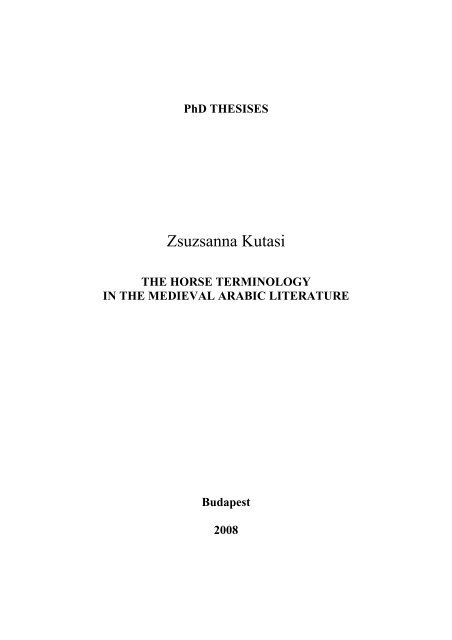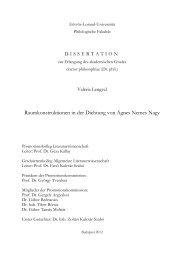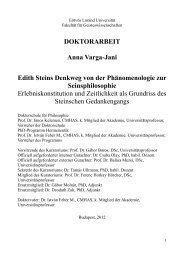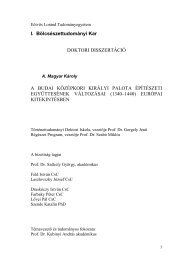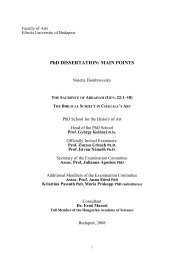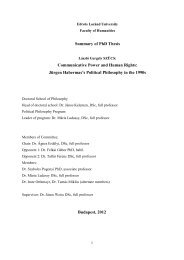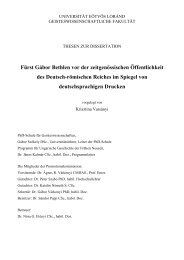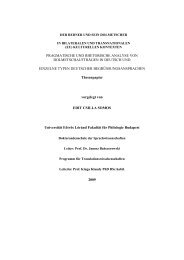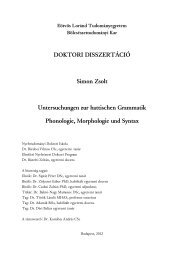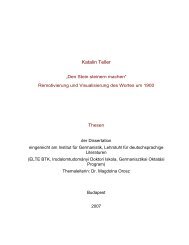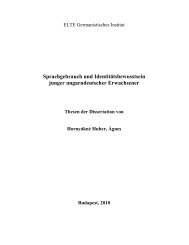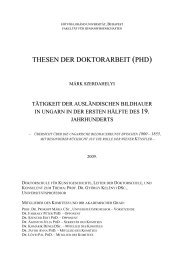Zsuzsanna Kutasi - ELTE BTK disszertációk
Zsuzsanna Kutasi - ELTE BTK disszertációk
Zsuzsanna Kutasi - ELTE BTK disszertációk
Create successful ePaper yourself
Turn your PDF publications into a flip-book with our unique Google optimized e-Paper software.
PhD THESISES<br />
<strong>Zsuzsanna</strong> <strong>Kutasi</strong><br />
THE HORSE TERMINOLOGY<br />
IN THE MEDIEVAL ARABIC LITERATURE<br />
Budapest<br />
2008
1. The Aim and the Theme of the Essay<br />
In this essay my aim is to give an outline of some expressions concerning the bodyparts<br />
of the horse and to attempt approaching the Arabs’ thinking in this area.<br />
If one reads one of the Arabic hippological books, he will have some new or unknown<br />
words for him among the different explanations about the places of the body-parts of the<br />
horse, like the different parts of the forehead, the croup, the side or the hoof. For example the<br />
„frog” in the European languages means the horny-matter part at the sole of the hoof, between<br />
the sulci. In the Arabic texts the ”frog” (Ãifda‘) is inside the hoof, perhaps it means the<br />
navicular bone, and the part which protrudes from the sole of the hoof is called the „eagle”<br />
(nasr/nusūr). This word we cannot find in any of the European languages.<br />
There is another interesting speciality among the names of the horse's body parts,<br />
namely that 17 of them bear flying animals' names – sparrow (the root of the forelock), owl<br />
(top of the head), fly (tip of the ear), sparrow-hawk (vein under the tongue), butterfly<br />
(temporal bone and tongue bone), wasp (or bee-queen) (white stripe on the nose that reaches<br />
neither the forehead nor the nostrils below), swallow (hair ridge at the front part of the neck),<br />
eagle (frog at the bottom of the hoof), eaglet (fleshy part near the point of the shoulder),<br />
falcon (groin), sandgrouse hen (the back at the groin) and cock (flank), crow (the upper part<br />
of the croup above the tail), starling (the rear part of the croup), hawk (the upper part of the<br />
neck at the nucha), bat (the place on the horse's sides behind the elbows), pidgeon (anus).<br />
Perhaps they are references to the speed of the horse, or there may be some other<br />
(symbolic?) connection with these birds. For example the eagle (nasr) symbolizes for the<br />
Arabs, clear sight, long life and speed. 1 The expressions of long life and speed are also linked<br />
to the „frog” (the fleshy part of the hoof), and the health of this part is very important for the<br />
horse. This body part's name (nasr – eagle) is one of the names that remained from the<br />
medieval Classical Arabic words, in the inventory of modern Arabic expressions, unlike the<br />
Arabic „frog” (ÃifdaÝ), which has disappeared from among the old terms. Perhaps this body<br />
1 ar-RāÈib al-IÒfahānÐ: MuÎÁÃarÁt al-ÞudabÁÞ. Beirut, Dar Sader 2004. pp. 722., 780-781.<br />
* I would like to express my gratitude to Professor Shauqi who has kindly given me his valuable help in getting<br />
some of the source material that I have relied on in this article. I also thank everyone who has in any way helped<br />
me form my ideas that the article rests on.<br />
2
part's name has changed because of its parallelism with the meaning of the European<br />
termination concerning to other body part. The Arabs did not want to delete „eagle” from<br />
among the hoof's parts, and therefore they gave a new name to the Arabic „frog”: al-ÝaÛm<br />
az-zawraqÐ. The frog as an animal species has been registered in the thinking of the Arabs as<br />
one that fell down from among the clouds. It has no bones, and it was the rain that created it<br />
out of the earth.<br />
It could not be impossible to separate the dialectal words concerning to horse's body parts and<br />
the scientifical expressions to them. It seems like they complete each other. The classical<br />
meanings of these words are change sometimes, they are widen or disappear or they get a new<br />
meanings. The account for changes of these anatomical names the more exact explanation of<br />
the body parts. In the Middle Ages the hippological books were written by philologists and<br />
they look like a register books of anatomy without illustrations. Later, in the 12th-15th<br />
century, appeared the illustrated anatomical books about horses, but these works and the<br />
figures in them are very similar to each other as they are routine duties. Perhaps the cause of<br />
this similarity is the standardization of anatomical expressions, which began in the 11th<br />
century.<br />
1.1. The description of the horse in the historical texts.<br />
We can classify in many ways the different descriptions telling us about the body-parts<br />
of the horse. One of these versions is that wherein the horse is described by scientists or<br />
philologists. This kind of description we can find in essay form in historical and geographical<br />
texts 2 (and also in the Îadīts), which are not dedicated specifically to horses, but mention them<br />
because of their prominent role among the Arabs. The horses in these works are mentioned as<br />
battle-tools after the camels, and directly follow the description of weaponry. They tell<br />
eloquently what a good or noble horse looks like, and what are those things that need to be<br />
long on its body, and what parts are short or wide or smooth, and so on. These fragments are<br />
good /fairly typical examples:<br />
ﺎﻣأ ،فﺮﻘﻤﻟا ﺊﻄﺒﻤﻟا ﻦﻣ ﺮﺒُﻤﻟا داﻮﺠﻟا فﺮﻋأ لﺎﻗ ،؟ﻢﻳﺮﻜﻟا سﺮﻔﻟا فﺮﻌﺗ<br />
: ﺪﺳأ ﻲﻨﺑ ﻦﻣ ﻞﺟر ﻞﺌﺳ : لﺎﻗ ﻲﺑاﺮﻋﻷا ﻦﺑا -<br />
ﺊﻄﺒﻟا ﺎﻣأو ،ّبﻸﺗا ﺐﺼﺘﻧا اذإو ّﺐﻌﻠﺟا ﺪﻴﻗ اذإو ّﺐﻬﻠﺳا اﺪﻋ اذإ يﺬﻟا ،ﺮﻴﺴﻟا ﻒﻴﻧﺄﺗ ﻒّﻧأو ﺮﻴﻌﻟا ﺰﻬﻟ ﺰﻬﻟ يﺬﻟﺎﻓ ﺮﺒﻤﻟا داﻮﺠﻟا<br />
. ﻲﻨﻜﺴﻣا لﺎﻗ ﻪﺘﻠﺳرأ اذإو ﻲﻨﻠﺳرا لﺎﻗ ﻪﺘﻜﺴﻣا اذإ<br />
يﺬﻟا ،ﺔﺒﻠُﺠﻟا ﺮﻴﺜﻜﻟا ﺔﺒﻗﺮﻟا ﻆﻴﻠﻐﻟا ﺔﺒﻧرﻷا ﻢﺨﻀﻟا ﺔﺒﺠﺤﻟا كﻮآﺪﻤﻟﺎﻓ فﺮﻘﻤﻟا<br />
2 Al-Nuwayrī, Nihāyat al-’arab. 1933 Cairo, vols. 25/10. pp.19-55. Ibn Sīda, al-MuhaÒÒaÒ. Beirut n.d. vols.<br />
6/2. pp. 138.-147. Al-MaÒ‘ūdī, Murūğ al-dahab. Beirut n.d. vols. 2/2. pp. 696.<br />
3
Ibn al-’A‘rābī said: A man from the Banū Asad tribe was asked once if he knew the noble<br />
horse. And the man said: I can distinguish the good running steed from the lowly- descended<br />
and slow horse. As regards the swift steed, its stature is that of the wild-donkey and its walk is<br />
equal. Its gallop is extended, and if its (feet are) in fetters, it is resting on the ground quietly,<br />
and it is standing firm. Whereas the slow walked and lowly-descended horse has a sloping<br />
croup, and the tip of its nose is bulky, and its neck is thick with many scars on it. If you<br />
wanted to stop this kind of horse, it would go instead (it tells you to let it run away), and if<br />
you wanted it to go, it is halting (it asks you to stop him instead). 3<br />
ﺾﻳﺮﻌﻟا ،ثﻼﺜﻟا ﻞﻳﻮﻄﻟا : لﺎﻘﻓ ؟ﻞﻀﻓأ<br />
ﻞﻴﺨﻟا ّيأ : ﺔﻳوﺎﻌﻣ ﻪﻟﺄﺳ ﺪﻗو نﺎﺻﻮﺻ ﻦﺑ ﺔﻌﺼﻌﺻ ﻦﻋ ﺖﻠﻘﻧ ًﺎﻀﻳأ ﺔﻳﺎﻜﺤﻟا ﻩﺬهو -<br />
ﺮﻴﺼﻘﻟا ﺎﻣأو ماﺰﺤﻟاو ﻖﻨﻌﻟاو نذﻷﺎﻓ ثﻼﺜﻟا ﻞﻳﻮﻄﻟا ﺎﻣأ : لﺎﻗ . ﺎﻨﻟ ْﺮﱢﺴَﻓ : ﺔﻳوﺎﻌﻣ لﺎﻗ . ثﻼﺜﻟا ﻲﻓﺎﺼﻟا،ثﻼﺜﻟا ﺮﻴﺼﻘﻟا ،ثﻼﺜﻟا<br />
ﻦﻴﻌﻟاو ﻢﻳدﻷﺎﻓ ثﻼﺜﻟا ﻲﻓﺎﺼﻟا ﺎﻣأو . كرﻮﻟاو ﺮﺨﻨﻤﻟاو ﺔﻬﺒﺠﻟﺎﻓ ثﻼﺜﻟا ﺾﻳﺮﻌﻟا ﺎﻣأو ﺐﻴﻀﻘﻟاو ﺐﻴﺴﻌﻟاو<br />
ﺐْﻠُﺼﻟﺎﻓ ثﻼﺜﻟا<br />
. ﺮﻓﺎﺤﻟاو<br />
This story also originates from Ña‘Òa‘ b. ÑūÒān, who once asked Mu‘āwiya: Which is the<br />
best horse? He said: (It has) three long, three wide, three short and three pure (parts).<br />
Mu‘āwiya asked: Explain it us! He said: The three long (parts) are the ears, the neck and the<br />
side where the saddle 4 is. The three short are the spine, the root of the tail and the penis. The<br />
three wide is the forehead, the nostril(s) and the croup. The three pure is the skin 5 , the eye(s)<br />
and the hoof(s). 6<br />
ﺐﻴﺴﻋ ﺮﻴﺼﻗ غﺎﺳرﻷا ﺮﻴﺼﻗ ،ﺔﻴﺻﺎﻨﻟا ﻞﻳﻮﻃ بﺮﻗﻸﻟا ﻞﻳﻮﻃ ﻦﻴﻋارﺬﻟا ﻞﻳﻮﻃ ﻦﻴﻧذﻷا ﻞﻳﻮﻃ ﻖﻨﻌﻟا ﻞﻳﻮﻃ ةﺪﻴﺒﻋ ﻮﺑأ لﺎﻗ -<br />
نﺎﺒﻠﻟا ﺾﻳﺮﻋ ﺔﻬﺒﺠﻟا ﺾﻳﺮﻋ . ﺮآﺬﻟا<br />
ﻲهو ﻲﻀﻨﻟا ﺮﻴﺼﻗ قﺎﻔﺼﻟا قﻮﻓ ﺔﺒﺼﻋ ﻲهو ةﺮﻃﻷا ﺮﻴﺼﻗ ﺮﻬﻈﻟا ﺮﻴﺼﻗ ﺐﻧﺬﻟا<br />
( ﻩﺮﺧﺁ ﻰﻟإو)<br />
ﻦﻴﻧذﻷا ﻰﻨﺜﻣ ﺾﻳﺮﻋ ﻦﻴﻠﺟﺮﻟا ﻲﻔﻴﻇو ﺾﻳﺮﻋ ﻦﻳﺬﺨﻔﻟا ﺾﻳﺮﻋ مﺰﺤﻤﻟا ﺾﻳﺮﻋ<br />
Abū ‘Ubayda said: (the good horse is) long necked, long eared, long forearmed, long<br />
shanked, long forelocked, short pasterned, short rooted of its tail, short backed, short flanked,<br />
short penised, wide foreheaded, wide chested, wide haunched, wide thighed, wide cannoned<br />
on the hind legs, wide placed between the two ear-roots 7 (and so on).<br />
1.2. The description of the horse in the hippological books.<br />
3<br />
Ibn Qutayba, al-ma’ānī al-kabīr. /kitāb al-faras. Beirut 1953. vols. 3/ pp. 109.<br />
4<br />
Íizām means the girth, and if its long, it means that the side of the horse is wide. The name of this part of the<br />
horse is maÎzim.<br />
5<br />
The short, smooth haired and single coloured coat.<br />
6<br />
Al-Nuwayrī, Nihāyat al-’arab. 1933 Cairo, vols. 25/10. pp. 19.<br />
7<br />
Ibn Qutayba, al-ma‘ānī al-kabīr /kitāb al-faras. Beirut 1953. pp. 110.<br />
4
The other kind of description also comes from the philologists, but these books are<br />
devoted exclusively to horses under the title of Kitāb al-hayl or Kitāb al-faras, and are of<br />
course more detailed than the aformentioned works. And among these are the hippological<br />
works in the form of practical handbooks for horsemen or soldiers that the Kitāb al-furūsiyya.<br />
These works describe the horse from the tip of the ears to the soles, including its inner bodyparts<br />
also, as a kind of anatomical books, but with a lot of fragments from poems as a kind of<br />
support to buttress the definitions of the descriptions of the body-parts of the horse. The<br />
sources of these works are the expressions used by the Jāhiliyya’s poets and the Bedouins,<br />
who trained the horses on the desert fringes or in the oases.<br />
1.3. The descriptions of the horse in the poems.<br />
And this leads us to the third kind of description, namely the poems that serve as the<br />
basis of the aforementioned works. The following are examples:<br />
مﻮﻋﺮﺑ ﻪﻧﺄآ ﻲﻀْﺒَﻧ ﺐﻠﻗو ﻦْﻴَﺗوْﺮَﻤﻟﺎآ ﺎهﺎﺘﻴﻠآ -<br />
Its two kidneys are like two flints, and the sound of its throbbing heart like the trembling of<br />
the flower’s petal 8<br />
ﺐﺛو رﺎﺒﺧ<br />
ﻩﺎﺤﺘﻧا ﺎﻣ اذا عارﺬﻟا ﻲﻣﺎﺳ ﻦﻴﺗﺎﻤﺤﻟا حوﺮﺿ -<br />
The two muscles of its thigh and its forearms are so tight when it wants to jump from the<br />
bottom of the hole. 9<br />
ﺮﻌﺸﻟا ﻲﻓﺎﺿ ﺎﻬﻨﻋ ﻒﺸﻜﺗ ﻦﻴﻌﻟاو<br />
ﺰﻬﻟ ﻎﺿﺎﻣو ﻊﺷﺎﺧ ﺐﺟﺎﺣو -<br />
Humble eyelids, strong masseters and the eye that the opulent forelock leaves bare. 10<br />
ﺮﻓاﺰﻟا ﺪﻳأ ﺆﺟﺆﺟ ﻰﻟإ<br />
It has a tail like the dress’s tail, reaching the deep-sighed chest. 11<br />
5<br />
يﺪﻬﻟا ﻞﻳذ ﻞﺜﻣ ﺐﻧذ ﺎﻬﻟ -<br />
ﺐﺴﻘﻟا ىﻮﻨآ ارﻮﺴﻧ ﻪﻴﻣاﻮﺣ ﻦﻴﺑ ىﺮﺗ -<br />
You can see between (the two parts of) its sulci the frogs that so hard as a date’s kernel. 12<br />
2. Problems of interpreting the names of a horse's body parts.<br />
We need some help to understand these poems regarding the body-parts of the horse<br />
and generally we can find this assistance in the author’s commentary in the foot-notes. The<br />
first problem is added when the critical word (concerning one of the body-parts of the horse)<br />
8 ibid pp. 55.<br />
9 ibid pp. 20.<br />
10 ibid pp. 115.<br />
11 ibid pp. 149.<br />
12 ibid pp. 168.
is examined in different ways by different authors, and they tend to have different<br />
interpretations in the case of any word. For example in the case of „sāq” the word means tibia<br />
(Classical Arabic L.), or cannon (in Saudi dialect), or else the bone of the forearm, or a lot of<br />
other things also 13 . “Ğubba” means ankle, hoof, or the two bones of the pastern. 14 “Dirā‘”<br />
means forearm (CAL), or cannon 15 . “Zawr” means the part of the thorax from the first rib to<br />
the sixth (CAL), or the throat 16 , and so on.<br />
2.2.Combinations between the terminology of the horse and the terminology of other animals.<br />
Sometimes one of the commentators think that the description refers to a camel or a<br />
wild donkey or something else, (for example, to an arrow), and not to a horse. See an<br />
example of this:<br />
ُزِوﺎﻌﻤﻟا ﺎﻬﻴﻠﻋ ْجَرﺪﺗ ﻢﻟو ًاﺮﻴﺒَﺣ ْﺖَﻣِﺮْآُأو ْﺖَﻨﻴﺻ ءاﺪﻧﻷا ﻂﻘﺳ اذإ -<br />
By the time the morning dew have fallen, it was wrapped up in fine clothes carefully not in<br />
worn rags, and great attention was paid to it. 17<br />
Here the verse deals with an arrow, and not with a noble horse, but the horse might also be<br />
drapped in fine clothes so that it should not catch a cold at dawn.<br />
ﺪﺻﺎﺣ ءﺎﺑﻷا ﻖﻳﺮﺣ<br />
6<br />
ﻪﻧﺄآ اوﺄﺷ ﻦﻴﻔﻄﻌﻟﺎﺑ ﺞﻟﺎﻌﻳ -<br />
Shows his two sides one after another on the hop as he is a fire piled up from pieces of wood<br />
by a reaper. 18<br />
We can find the same verse at the horse's description and at the wild ass also.<br />
ﻞﻈﻨﺣ ﺔﻳاﺮِﺻ وأ سوﺮﻋ كاﺪﻣ ىﺮﺟ اذا ﻪﻨﻣ ﻦﻴﻔﺘﻜﻟا ﻰﻠﻋ نﺄآ -<br />
Like on his two shoulders is the bride's little millstone for her eye-powder or the colocynt's<br />
juice. 19<br />
Both of them are yellow, but the horse's sweat is white therefore I think that we can read here<br />
about the camel instead.<br />
Sometimes we can see some names among the names of horse's body parts, which originally<br />
participated to the camel's or the sheep's terminology. For example „kalkal” (part of the chest,<br />
13<br />
Practical animal biology. Cairo, 1980. vols. 3<br />
14<br />
Ibn Sīda, al-muhaÒÒaÒ. Beirut n.d. vols 6/2. pp.145.<br />
15<br />
Carl Raswan, Vocabulary of Bedouin words. JNES 4/1945, Alois Musil, The Manners and customs of the<br />
Rwala Bedouins. New York, 1928.<br />
16<br />
Egyptian dialect (Kitāb al-ma‘ārif al-‘ilmī/ al-huyūl. Cairo,2001.), Janet C. Watson, Lexicon of Arabic Horse<br />
Terminology. London, 1996.<br />
17<br />
Dīwān al-Šammāh b. Âirār. Cairo, 1977. pp. 193.<br />
18<br />
Ibn Qutayba, al-ma’ānī al-kabīr / kitāb al-faras. Beirut 1953. pp. 18. and 28.<br />
19<br />
Ibn Qutayba, al-ma’ānī al-kabīr / kitāb al-faras. Beirut 1953. pp. 137.
that reach the earth if the camel/horse lies down) or „baraka/birka” (chest of the camel/horse)<br />
or k(i)rÁÝ (rear cannon of the sheep/horse in the Syrian dialect).<br />
3. Another classification of the horse's body parts' descriptions.<br />
According to another classification of descriptions, in which the author names the<br />
inner as well as the outer parts of the horse’s body, we can distinguish five types of such<br />
comments.<br />
3.1., Visual description – as in the case, for example, of the muÎayyan (the place of<br />
the forehead at which the two bones leading to the eyes fork off), Îadaqatān (black circle in<br />
the eyes), nawāhiq (well-visible bones under the eyes), mudammar (the part of the neck<br />
behind the ear-bones), ġurābān (upper part of the croup, where the two muscles join),<br />
fahdatān (protruding part of the chest near the shoulder), mukÎulān (well-visible bone inside<br />
the carpus), ašğa‘ān (protruding bone on the inside part of the cannon).→ This kind of view<br />
describes the easily visible, or salient characteristic parts of the horse’s body.<br />
3.2., Description of the mount (saddle-horse) – as we can see for example in the<br />
case of qadāl (place behind the forelock in which the halter is put), marsin (the place of the<br />
halter’s nose-strap), mustaÔ‘am (the place between the halter’s nose-strap and the lips),<br />
sālifatān (place of the collar, upper part of the neck up to the ear bone), qaÒara (part of the<br />
neck behind the place where the collar is put), kātiba (place on the withers before the rider),<br />
Òahwa (the rider’s seat on the back of a horse), qaÔāa (place behind a rider on the back of<br />
the horse, the place of the second rider), ma‘addān (the two sides of a horse at the place of<br />
the rider’s feet), markal (the place on the horse’s sides at which the rider urges it for a gallop,<br />
behind the elbows), ÒafÎatān (the two sides of the thorax of the horse, where the rider’s<br />
thighs touch them), dā’irat al-qāli‘ (tuft at the place of the saddle, on the horse’s back),<br />
dā’irat al-‘amūd (tuft at the place of the collar). → With this kind of description, the author<br />
explains the body-parts of the horse in relation to its rider. According to this kind of view we<br />
need to know the harness (the bridon and the saddle) and the rider’s attitude on the back of the<br />
horse. The horse and its rider appears together in this description like one single living<br />
creature.<br />
3.3., One name referring to two or more places on the horse. – For example, dubāb<br />
(tip of the ears, and the iris in the eyes), watra (part between the two nostrils, and part<br />
between the hock and the stifle), raÃfa (small, independent “bone” inside the hoof between<br />
7
the coffin bone and the frog ~ cartilage, small bone in the knee ~ patella, small bone between<br />
the cannon and the pastern), ma’bià (round mobile bone at the rear part of the knee (rukba),<br />
joint between femur and tibia, on the outer part of the patella).→ This type of identification<br />
gives explanations of such body-parts as resemble one another in shape, matter/tissue or other<br />
common characteristic (cartilage, joint, tendon).<br />
3.4., The body parts as compared to each other. → This kind of description is also<br />
visual (1.), but the explanation of the body parts is based on the parts connected with them as<br />
though they formed a kind of “chain”. Such explanation is utilized, when the bigger parts are<br />
divided into smaller ones, for example on the forehead, on the hoof and on the croup. The<br />
parts of the forehead are the nāÒiya (the forehead under the forelock above the ğabha), the<br />
ğabha (part of the forehead under the ears, above the ğabīn), the ğabīn (the place above the<br />
eyes, under the ğabha), the laÔma (the centre of the ğabha), the muÎayyan (the place of the<br />
forehead, at which the two bones leading to the eyes fork off, under the nāÒiya). All of these<br />
Arabic names correspond to one single term in the European languages, and that is the<br />
forehead. The forehead has anatomically (topographically) four main parts: squama<br />
temporalis, pars nasalis, pars orbitalis and pars temporalis. These parts are too small places on<br />
the forehead to identify them with one of the Arabic expressions.<br />
The description of the hoof (Îāfir) – I will return to it later in more detailed form – is similar<br />
to European descriptions with the exception of the frog and the heel. One part of this<br />
description is visual, but the other parts demand more attention because of their chain-like<br />
form, like this one: The sunbuk is the wall or the horny wall. The al-’am‘ar (sensitive lamina)<br />
is between the sunbuk and the salīm (white line). The salīm is between the al-’am‘ar and the<br />
ÒaÎn (sole). The ÒaÎn is between the futūr (bars) and the salīm. The futūr is at the edge of the<br />
nasr (frog). The fağwa (gap, centre of sulci) is between the Îawāmī (sulci). The Îawāmī are at<br />
the rear part of the hoof, on the two sides of the fağwa. The na‘r (gap between the two bulbs)<br />
is at the rear part of the hoof (’alya). The dawābir (heel) is on the top of the ’alya and on the<br />
two sides of the ’umm al-qirdān (short pastern bone). The ’umm al-qirdān is between the<br />
’alya and the marīÔ (long pastern bone) inside the rusġ (pastern). 20<br />
The croup has two kinds of description too, the visual and the chain-like type. The all croup is<br />
the warik, but this word means also the m. biceps femoris, the biggest muscle of the croup.<br />
The warik is between the Îağabatān (top of the croup) and the ğā‘iratān (semitendinosus).<br />
20 Abū ‘Ubayda: Kitāb al-hayl. Cairo,1986. pp. 136-137.<br />
8
The Îağabatān are the two tops of the warik. The tuwwāra is in the centre of the warik. At the<br />
rear part of the croup, next to the ğā‘iratān is the ‘ağb. The tuffāÎa is on the top of the fahid<br />
(thigh), inside of the warik. 21 The Òalā is between the two parts of the warik.<br />
3.5., This type of description is similar to the third one, but contrary to that here, two<br />
or more things bear the same name. These things are in the same place, but are not<br />
identical. For example, the nāÒiya (the forelock and the part of the forehead under it), just as<br />
the sālifa ( a part of a neck and the mane above it) 22 . Qawnas means the place above the<br />
forelock, properly speaking the top of the head, and the mane above it.<br />
4. The method of Abū ‘Ubayda’s description.<br />
The above analysis has been made on the basis of Abū ‘Ubayda’s 23 Kitāb al-khayl (Book<br />
about Horses), because this is the very best and most detailed description about the horse in<br />
my opinion. In this book, the author has divided the horse’s body into eight parts from its<br />
head to its hind legs. These are (1.) the head, (2.) the neck, (3.) the back, (4.) the shoulders<br />
with the chest and the forearms, (5.) the front legs, (6.) the body and the inside parts, (7.) the<br />
croup and the thigh, (8.) the hock and the hind legs.<br />
This sort of description is very useful for someone who wants to find the meaning of certain<br />
body parts, for example, who wants to know the meaning of qaÔāa. He can find this name<br />
among the back’s parts in Abū ‘Ubayda’s book and not at the description of the croup,<br />
although its translation is the upper part of the croup, or simply the croup and not the back. In<br />
European thought, the back extends from the withers to the tip of the croup, thus this<br />
expression means both being on the edge of these two parts. The qaÔāa (in the form al-qatan)<br />
is occurs in Fonahn’s dictionary 24 as regio lumbalis, therefore this name is not specific to the<br />
horse’s terminology, where it is described as the “place behind the rider on the back of a<br />
horse”.<br />
5. Reading problems of the Arabic horse-terminology.<br />
21<br />
ibid pp.143.<br />
22<br />
ibid pp. 125, 185.<br />
23<br />
Abū ‘Ubayda (d. 209/824-5), Mesopotamian of a Persian origin (and possibly Jewish descent too) philologist<br />
and a polymath.<br />
24<br />
A. Fonahn, Arabic and Latin Anatomical Terminology chiefly from the Middle Ages. 1922. pp. 123.<br />
9
When the name of a smaller part within a bigger body part has been translated from Arabic<br />
into one of the European languages, it was collapsed into the bigger one’s name. Thus the<br />
smaller part is named with the bigger’s name: the croup, the chest, the neck or the hoof and so<br />
on. But we can find similar simplifications in the Arabic authors too, for example, in the case<br />
of markal and ma‘add. While Abū ‘Ubayda has distinguished them and said that the markal<br />
was the place on the horse’s sides, at which the rider urges it (yurakkiluhu) for a gallop,<br />
behind the elbows, it seems that the ma‘add does not really have the same meaning: two sides<br />
of a horse at the place of a rider’s feet, hard, stiff muscular tissue on its two sides, behind the<br />
shoulders. 25 Namely this is a description of a body part anatomically, and not merely the<br />
identifications of a place on the horse’s body. Thus the two expressions do not mean the<br />
same, yet some authors do not distinguish them because of their identical location. For<br />
example al-’AÒma‘ī (d. 213/828) in his Kitāb al-khayl, who seems a more practical scientist<br />
than Abū ‘Ubayda, held both of them to be the same thing, but then he is not so meticulous in<br />
the description of the horse.<br />
As to the ma‘add, al-Nuwayrī (d.733/1333) says that it is at the place of the girth on the<br />
horse’s sides. 26<br />
Ibn Sīda (d.488/1066) has collected a lot of explanations from different authors about the<br />
body parts of the horse. 27 For example, the Îawšab means for Abū ‘Ubayd the interior of the<br />
hoof (Îašw al-Îāfir), just like the ğubba (ankle). Abū ‘Ubayda states that the Îawšabān means<br />
the two bones of the pastern (rusġ). Ibn Sikkīt holds that the ğubba is the same as the Îāfir.<br />
The ğubba means in the al-mu‘ağam al-wasīÔ the joint between the sāq (tibia) and the fahid<br />
(thigh), namely the stifle. Its means also the Îiğāğ (palpebra) in the eyes. If we look into the<br />
muÎīÔ al-muÎīÔ, the ğubba means, beside the above, the connecting part between the Îāfir<br />
and the waÛīf (cannon). Since this description does not mention the pastern between the hoof<br />
and the cannon, we can conclude it that the Îāfir means both the hoof and the pastern together.<br />
The Îāfir as nail sometimes replaced with the word sunbuk (the wall), but in the meaning of<br />
“hoof”. (See above, when the smaller part was named by the bigger’s name.)<br />
Al-MaÒ‘ūdī quotes a short story 28 from the time of the caliph ‘Umar (634-644), who held<br />
examination for the horse to determine their nobility. They put a vessel full of water on the<br />
ground and led the horses one after an other to drink from it. That horse which drank from the<br />
25 Abū ‘Ubayda, Kitāb al-hayl. Cairo, 1986. pp. 204.<br />
26 Al-Nuwayrī, Nihāyat al-’arab. 1933 Cairo, vols. 25/10. pp. 2.<br />
27 Ibn Sīda, al-muhaÒÒaÒ. Beirut n.d. vols 6/2. pp. 138.<br />
28 Murūğ ad-dahab, Beirut, 1989. vols. 2/2. pp. 696.<br />
10
vessel with its forelegs upright, since its neck was long enough to reach the water, was<br />
declared a noble one, and that horse which bent its forelegs because of its short neck was<br />
recorded as a common horse. The expression “bent its forelegs” was expressed with the terms<br />
Îāfir (ğādat Îawāfiruhu) or sunbuk (tanā aÎad as-sunbukayn) in the same meaning. Yet the<br />
hoof cannot bend itself, which only the pastern can. Thus I think that here the Îāfir or sunbuk<br />
mean the hoof and the pastern together. In that case, Ibn Sikkīt may be right in stating that<br />
“the Îāfir means the ğubba”, namely the part from the hoof to the ankle is the Îāfir.<br />
According to the muÎīÔ al-muÎīÔ, the meaning of the Îāfir is the same as the human’s foot<br />
(qadam), on which one goes. In comparison of the horse’s skeleton with that of the human,<br />
the human’s qadam is the same as the horse’s hind leg from the hock to the hoof. So the Îāfir<br />
is the general name of the hoof, which the horse goes on, and not that of the nail only.<br />
6. Changes of the names of the horse's body parts in the modern age.<br />
If we compare the names of the horse’s body parts in the Middle Ages with the<br />
corresponding names in our times, we will find that the modern age has opted for the practical<br />
style of al-’AÒma‘ī, and prefers to use the simple and definite expressions from the Classical<br />
Arabic terminology of the horse. Thus have disappeared from the hoof’s parts names like<br />
dahīs (coffin bone), ’umm ul-qirdān (short pastern bone), marīt (long pastern bone) and<br />
modern expressions translated from the European languages like the first foot bone (long<br />
pastern bone – at-tulāmā al-awwal), the second foot bone (short pastern bone - at-tulāmā attānī)<br />
and the third foot bone (coffin bone - at-tulāmā at-tālit) have taken their place. The<br />
sunbuk has disappeared and became ğidār al- Îāfir (wall of the hoof) instead. The old name of<br />
the white line in the hoof (salīm) has changed into al-haÔÔ al-abyaà (white line). The names<br />
of the smaller parts of the chest and the croup have also disappeared and only the bigger parts’<br />
names have remained. As from among the names of medieval division of the forehead<br />
remained the ğabha only, meaning the whole forehead. The ka‘b in the CAL means the hock,<br />
but in the modern dialects means the heel on the hoof. The cause of the appearence of this<br />
word at the place of the heel is the above mentioned similarity with the names of the human’s<br />
body parts.<br />
7. Connections between the dialectical variations and the Classical Arabic language.<br />
11
I have collated four different collections concerning the names of the horse’s body<br />
parts. Two groups from these words are in the Syrian and Saudi dialects, and the other two<br />
froms Egyptian and Iraqi agricultural school-books together with a modern expressions for<br />
them. I have compared them with the Classical Arabic terminology and found that among the<br />
dialectical words, some Classical Arabic expressions are preserved, but with meanings<br />
different from those in the Middle Ages. Thus zawr in the Saudi dialect means the chest,<br />
instead of the place of the first six ribs on the horse’s side, (as in Classical Arabic Language)<br />
and in the Egyptian dialect means the throat like in the case of a human. According to the<br />
explanation of the al-Mu‘ağam al-wasīÔ, the zawr is the meeting point of the first ribs at the<br />
bottom of the chest, which means that it should be at the bottom of the chest and on the place<br />
behind the elbows too. It depends on the author’s interpretation what he means by the term.<br />
The best way for us to find a correct meaning of a word concerning one of the horse’s body<br />
parts, if we know the author’s living place. It is impossible to explain a Saudi horse’s<br />
description with the horse terminology in Iraqi or in Egyptian dialects. For example sāq (tibia)<br />
means in Saudi dialect cannon, and on the place of the CA sāq is the fahid /afhād (thigh in<br />
CA). Sāq means the cannon at the human’s body parts, therefore I think that the Saudi<br />
Bedouins named the horse’s body parts like they did it at the case of the human, but they did<br />
not name it in anatomically meaning.<br />
Then the foremost cause of the difference among the interpretations referring to the<br />
horse’s body parts is the false correspondences to the human’s parts. As we know, in the place<br />
of the horse’s hocks are our heels, and our feet are similar to the horse’s cannons, our fingers<br />
and our nails correspond to the horse’s pasterns and its hoofs. In the Saudi dialect, the basis of<br />
comparison is the function and not the anatomy. We can see an excellent example of this<br />
among the names of the camel’s body parts 29 , where the names are “slipped up” on the hind<br />
legs because the tibia’s name is lacking on it. Its name is in the place of the cannon. Likewise,<br />
on the fore legs the upper arm is in the place of the forearm and the forearm is in the place of<br />
the cannon. (As the anatomical upper arm does not exists.) Therefore the Classical Arabic<br />
name of the cannon (waÛīf) is lacking. The book on the camel is replete with Classical Arabic<br />
verses which were written about the camel’s body parts as metaphors. Since there are many<br />
differences among the Classical Arabic interpretations and the modern Arabic descriptions<br />
concerning the camel’s body parts, thus the explanations in the verses are uncertain too.<br />
29 Al-ibil al-‘arabiyya al-aÒīla. Dār Ğarrūs Press, Libanon, 1990. pp. 68. and 83.<br />
12
If we have a look at the dictionaries collecting the medieval anatomical expressions<br />
concerning the human, we found that “mafÒil al-sāq wa-l-qadam” means ankle, which in the<br />
case of the horse corresponds to the ğubba (ankle). This fact shows unambiguously that the<br />
“qadam”, a word which means the same as Îāfir in some CA explanations and in the Saudi<br />
dialect too, connects with the sāq. Sāq here really means the cannon, but the connecting bone<br />
with it from above is the dirā‘ (forearm), and not the fahid (thigh), according to anatomy. 30<br />
Conclusion<br />
Thus we can see that the Arabs’thinking concerning to the body parts of the horse<br />
follows in many cases the names of other animal's body parts, for example the camel's or the<br />
sheep's (for example in Syrian dialect) or the human body parts. But these names do not<br />
follow seriously the anatomy, but the funtions of the body parts.<br />
2. Bibliography<br />
Classical Sources:<br />
- Abū c Ubayda, Hayl = Ma c mar b. al-MutannÁ at-Taymī Abū c Ubayda. Kitāb al-Hayl. Cairo,<br />
1986. (A Book About Horses)<br />
- al-AÝrābī, Asmā’ hayl al- c arab = Abū c Abdallāh MuÎammad b. Ziyād al-A c rābī. Kitāb asmā’<br />
hayl al- c arab wa-fursānuhā. Cairo: Maktabat an-Nahda al-MiÒriyya. 1984. (A Book<br />
About the Names of the Arab's Horses and Its Riders)<br />
- al-AÝrābī al-Aswad, Asmā’ hayl = Abū MuÎammad al-Aswad al-Ġundiğānī al-A c rābī. Asmā’<br />
hayl al- c arab wa-ansābuhā wa-dikr fursānihā. Sultānī, Muhammad c Alī. Damaszkusz:<br />
Maktabat al-Gundiğānī, Mu’assasat ar-Risāla. (A Book About the Names of Arab's<br />
Horses and Its Genealogy and Its Riders)<br />
- al- c Askarī, Ma c ānī = Abū Hilāl al- c Askarī, Dīwān al-ma c ānī. Cairo, dátum nélkül.<br />
(Collection of Poetical Themes)<br />
- al-AÒma‘ī, Hayl = Abū Sa‘īd ‘Abd al-Malik b. Qurayb, Kitāb al-hayl, Nūrī Íamūdī al-<br />
Qaysī, Baghdad 1970 (A Book About Horses)<br />
- al-AÒma‘ī, Hayl = Abū Sa‘īd ‘Abd al-Malik b. Qurayb, Kitāb al-hayl. Silsilat Kutub al-hayl.<br />
Kiadó: Íātim ÑāliÎ al-Âāmin, Damascus, Dār al-Bašā’ir, 2005 (A Book About Horses)<br />
30 In Hungarian language the sāq (szár) means the cannon and the tibia also, in French the sāq means „le canon”<br />
in both cases, in German the sāq means in both cases „e Röhre”. In English the sāq means „shank” and<br />
„cannon”.<br />
13
-al-Buhārī, ÑaÎīÎ=Abū ‘Abdallāh MuÎammad b. Ismā‘īl al-Buhārī. ÑaÎīÎ. Beyrout, 1997, al-<br />
Maktaba al-‘AÒriyya (Collection of Prophetic Pure Chain Traditions)<br />
-al-Damīrī, Íayāt al-Îayawān = Kamāl al-Dīn MuÎammad b. Mūsā al-Damīrī, Íayāt al-<br />
Îayawān al-kubrā. Damascus, 1978 Maktabat MuÎammad Íusayn al-Nūrī (The Life of<br />
Animals)<br />
- al-ĞāÎiÛ, Íayawān =Abū ‘Utmān ‘Amr b. BaÎr b. MaÎbūb al-mulaqqab bi-l- ĞāÎiÛ, Kitāb<br />
al-Íayawān, Dār wa Maktaba al-Hilāl, Beyrout 1986 (A Book About Animals)<br />
-al-Ğawziyya, al-Óibb al-NabawÐ= Ibn Qayyim al-Ğawziyya, Kitāb al-Ôibb al-nabawÐ Dār<br />
al-Turāt, Cairo, 1982 (The Book of Prophetic Heal)<br />
- al-IÒfahÁnÐ,AÈÁnÐ =Abū al-Farağ al-IÒfahÁnÐ,KitÁb al-AÈÁnÐ, Beyrout, DÁr al-Fikr.<br />
1995. (The Book of Songs)<br />
- al-Mas‘ūdī, Murūğ = Abū al-Íasan ‘Alī b. al-Íusayn b. ‘Alī al-MaÒ‘ūdī, Murūğ al-dahab wa<br />
ma‘ādin al-ğawhar, Beyrout, 1989 (Gold Meadows and Diamond Mines)<br />
- al-MufaÃÃaliyyāt = Abū al-‘Abbās al-MufaÃÃal b. MuÎammad al-Âabbī, Dīwān al-<br />
MufaÃÃaliyyāt, Abū MuÎammad al-Qāsim b. MuÎammad b. Baššār al-Anbārī. Maktabat al-<br />
Taqāfa al-Dīnīya. Cairo 2000.(Collection of Poems of al-MufaÃÃal al-Âabbī)<br />
-Muslim, ÑaÎīÎ =Abū Zakariyya YaÎya b. Šaraf al-NawawÐ al-DimašqÐ, ÑaÎīÎ. Beyrout, DÁr<br />
al-Fikr. 1941-42. (Collection of Pure Chain Prophetic Traditions)<br />
- al-NāÒirī, al-bayÔara wa al-zarÔafa (al-zarÔaqa) =Abū Bakr b. Badr al-Dīn al-<br />
BayÔār,(Ibn al-BayÔār), Kāšif hamm al-wayl fī ma‘rifat ’amrāÃ al-hayl aw kāmil al-<br />
Òinā‘tayn al-bayÔara wa al-zarÔafa (al-zarÔaqa) al-ma‘rūf bi-l-nāÒirī, Párizs-Sorbonne<br />
1991 (al-NāÒirī, The Art of Veterinary Medicine and of Hippiatry. The Importance of<br />
Recognising of Maladies of the Horse or The Total Glossary in Two Fields: the Veterinary<br />
Medicine and the Hippiatry)<br />
- al-Nuwayrī, Nihāyat = Šihāb al-Dīn AÎmad b. ‘AbdulwaÎÎāb al-Nuwayrī, Nihāyat al-arab fī<br />
funūn al-adab. Cairo, Dār al-Kutub al-MiÒriyya 1933. (Final Aim in the Art of the Literary<br />
Good Manners)<br />
- Al-ŠammÁh, dÐwÁn = Al-ŠammÁh b. ÂirÁr al-DubyÁnÐ, dÐwÁn with explanations of<br />
ÑalÁÎ ad-DÐn al-HÁdÐ Dar al-Maaref. Cairo, 1977. (Collection of Poems of al-ŠammÁh.)<br />
- Al-ÑāÎib Tāğ al-Dīn, al-BayÔara =Abū ‘Abdallāh MuÎammad b. MuÎammad b.‘Alī, Kitāb<br />
al-BayÔara, Frankfurt, 1984.(Veterinary Medicine)<br />
- Al-TawÎīdī, Risāla = Abū Íayyān ‘Alī b. MuÎammad al-TawÎīdī, al-Risāla al-BaÈdādīya<br />
Kiadó: Dār al-kutub, Beyrout 1980. (Research from Baghdad)<br />
14
-al-Óufayl al-Ġanawī, Dīwān = Óufayl b.‘Auf b. Ka‘ab al-Ġanawī, Dīwān al-Óufayl al-<br />
Ġanawī. MuÎammad ‘Abd al-Qādir AÎmad. Beyrout. Dār al-kitāb al-ğadīd. 1968. (Collection<br />
of Poems of al-Óufayl al-Ġanawī)<br />
-‘Antara, Dīwān = ‘Antara b. Šaddād, Dīwān ‘Antara. Szerk.: MuÎammad Saīd Mawlāwī<br />
al-Maktab al-Islāmī. Cairo, 1964.(Collection of Poems of ‘Antara)<br />
- Ayyām al- c arab fī-l-ğāhiliyya. Szerk. Ğād al-Mawlā MuÎammad AÎmad, c Alī MuÎammad al-<br />
Bağāwī, Ibrāhīm MuÎammad Abū al-FaÃl. Beyrout: Dār al-Ğīl. 1988. (The War Days of the<br />
Arabs Before Islam)<br />
- Ğawād c Alī, MufaÒÒal = Ğawād c Alī. al-MufaÒÒal fī tārīh al- c arab qabl al-islām.<br />
Baghdad: Maktabat an-Nahda. (Detailed Glossary of History of the Arabs)<br />
- Ibn ‘Abd Rabbihi, al-‘iqd al-farīd = Šihāb al-Dīn AÎmad al-ma‘rūf bi-Ibn ‘Abd Rabbihi, al-<br />
‘iqd al-farīd, MuÒÔafa MuÎammad al-Maktaba al-Tiğārīya al-Kubrā Cairo, 1935 (The<br />
Unique Collar)<br />
- Ibn al-Kalbī, Ansāb al-hayl =Ibn as-Sā’ib al-Kalbī, Ansāb al-hayl fī-l-ğāhiliyya wa-l-islām<br />
wa ahbāruhā. Szerk. AÎmad Zakī. Dār al-kutub wa al-watā’iq al-qawmiyya. Cairo, 1946,<br />
1965. (Genealogy and Stories of the Horses Before Islam and in Islam)<br />
- Ibn Hudayl al-Andalūsī, Íilyat al-fursān = ‘Alī b. ‘Abd al-RaÎmān al-mašhūr bi-Ibn Hudayl<br />
al-Andalūsī: Íilyat al-fursān wa šiÝÁr al-šuÊÝÁn Kiadó: al-Intišār al-‘arabī, Beyrout, 1997.<br />
(The Knights' Adornment and the Valiants' Costume)<br />
- Ibn ManÛūr, Lisān = Abū al-FaÃl Ğamāl ad-Dīn MuÎammad b. Mukarram b. ManÛūr.<br />
Lisān al- c arab. Beyrout, Dār Ñādir. 1990. (The Arabs' Language Dictionary)<br />
- Ibn Qutayba, Ma‘ānī = Abū MuÎammad ‘Abdullāh b. Muslim b. Qutayba al-Dīnawarī,<br />
Kitāb al-ma‘ānī al-kabīr fī abyāt al-ma‘ānī, F.Krenkow, Beyrout, Dār al-NahÃa al-Íadīta,<br />
1953 (Big Collection of Poetical Themes)<br />
-Ibn Qutayba, ‘Uyūn=Abū MuÎammad ‘Abdallāh b. Muslim b. Qutayba. Kitāb ‘Uyūn alahbār,<br />
Cairó, 1926 Dār al-kutub al-miÒriyya (Sources of Stories)<br />
- Ibn Sīda, MuhaÒÒaÒ = Abū al-Íasan ‘Alī Ibn Sīda, al-MuhaÒÒaÒ fī-l-luġa. Beyrout,<br />
Maktab al-Tīğārī. (Specialization in the Arabic Language)<br />
- Ibn Sikkīt, Tahdīb al-alfāÛ = Abū Yūsuf Ya‘qūb b. IsÎāq al-Sikkīt, Kanz al-Íuffāz - Kitāb<br />
Tahdīb al-alfāÛ, al-MaÔba’a al-Kātūlīkīya, Beyrout, 1895 (Treasure of the Oral<br />
Traditionalists – The Book About the Oral Teaching of Expressions)<br />
-Ibn Sīna, Qānūn= Abū ‘Alī al-Íusayn b. ‘Alī b. Sīna. al-Qānūn fī al-Ôibb. Baghdad (Order in<br />
the Cure)<br />
-Ibn Sīna, Qānūn= Abū ‘Alī al-Íusayn b. ‘Alī b. Sīna. al-Qānūn fī al-Ôibb. Beyrout, 1994 Dār<br />
al-Fikr<br />
15
- MuÎīÔ al-muÎīÔ = MuÎīÔ al-muÎīÔ muÔawwal li-l-luġa al-‘arabiyya BuÔrus al-BuÒÔānī<br />
Maktaba Lubnān Nāširūn. Beyrout 1998 (The Ocean of the Arabic Language. Dictionary)<br />
- al-MuÝğam al-wasīÔ = al-MuÝğam al-wasīÔ, Mağma‘ al-luġa al-‘arabiyya. Cairó 1985<br />
(Medium-sized Collection, the Collection of the Arabic Language. Dictionary)<br />
- Óabarī, Tafsīr =Abū Ğa‘far MuÎammad b. Ğarīr aÔ-Óabarī, Ğāmi‘ al-bayān fī tafsīr al-<br />
Qur’ān. 23/15. (al-Burāq) (Collection of Comments of the Koran)<br />
-Tābit b. Qurra, al-Dahīra=Tābit b. Qurra. al-Dahīra fī ‘ilm al-Ôibb. Beyrout, 1998 (The<br />
Thesaurus of Medicine)<br />
- ‘Urwa b.al-Ward, Dīwān = ‘Urwa b.al-Ward wa al-SamawÞal, Dīwānā ‘Urwa b.al-Ward<br />
wa al-SamawÞal. Kurm al-BusÔānī. Dar Sader. Beyrout, 1964. (Collection of Poems of<br />
‘Urwa b. al-Ward)<br />
Modern Sources:<br />
- Abū al-Qāsim AÎmad Rašwān, QirāÞat fī ši‘r al-hayl = Abū al-Qāsim AÎmad Rašwān,<br />
QirāÞat fī ši‘r al-hayl, Dār al-‘ilm Cairo 2000 (Reading of Poems About the Horses)<br />
- ‘Abd al-ÝAÛīm ‘Alī al-Qināwī, al-wasf fī al-ši‘r al-‘arabī. Cairo, 1949. (The Description in<br />
the Arabic Poetry)<br />
- al-Farā’id, J.G.Hava, = J.G.Hava, al-Farā’id al-durriyya Catholic Press, Beyrout 1964<br />
(Singularities as the Pearls Dictionary)<br />
- Al-ibil al-Ýarabiyya al-aÒīla. Dār Ğarrūs Press, Libanon, 1990 (The Noble Arabian Camel)<br />
- al-RāÈib al-IÒfahānÐ: MuÎÁÃarÁt al-ÞudabÁÞ. Beyrout, Dar Sader 2004. (Courses of<br />
Literateurs)<br />
-‘Amād al-Kuwayfī, al-nabātāt al-Ôibbīya wa fawā’iduhā, Damascus, 1990 (The Virtuous<br />
Plants and Its Curative Power)<br />
- Íusayn ‘Abd al-Íayy Qā‘ūd, al-huyūl = Íusayn ‘Abd al-Íayy Qā‘ūd és Mīrfat MaÎmūd Kāmil,<br />
al-huyūl, Kitāb al-ma‘ārif al-‘ilmī Dār al-ma‘ārif Cairó 2000 (Horses)<br />
- Qadrī al-ArÃarūmlī, al-hayl al-‘irāb = Qadrī al-ArÃarūmlī, al-hayl al-‘irāb wa faÃluhā<br />
‘alā al-insāl al-‘ālamīya Dār al-‘arabiyya, Baghdad. (The Arabian Horses and Their<br />
Advantages Compared with Other Horse Breeds)<br />
Secondary Sources:<br />
- Az állattenyésztés alapjai, Szerk. Nagy Nándor. Mezőgazda Kiadó. Budapest, 1996.<br />
16
- Állatorvosi szótár, Magyar-latin-angol-német. Összeállította és szerkesztette: Dr. Karsai<br />
Ferenc - Dr. Vörös Károly – Dr. Szieberth István. Mezőgazda Kiadó. Budapest, 2005.<br />
- Balassi Zsigmond, Lovak orvossága, Szerkesztette: Eckhardt Sándor Akadémia Kiadó,<br />
Bp.1957<br />
- Bodó Imre – Hecker Walter: Lótenyésztők kézikönyve, Mezőgazda Kiadó. Budapest, 1998.<br />
- Castleman, Michael, Gyógynövény enciklopédia (The healing herbs), A magyar kiadás<br />
alapja a Rodale Press Inc. 1991. évi amerikai kiadása.<br />
- Dunlop, Robert H., David J. Williams,Veterinary medicine an illustrated history, Mosby-<br />
Year Book, USA Missouri 1996.<br />
- El-Adly, Saber M. B.: Az amulett a mai Egyiptomban, <strong>ELTE</strong> Ókortörténeti Tanszék<br />
Kiadványai 31. Budapest, 1981.<br />
- Eliade, Mircea: Kovácsok és alkímisták, Cartaphilus Könyvkiadó, Budapest, 2004.<br />
-Fäller János, Növényeink a népies gyógyászatban, kuruzslásban és a babonában,<br />
Bölcsészetdoktori értekezés. Debrecen, 1943<br />
- Fehér György, Dr.: A háziállatok tájanatómiája, Mezőgazdasági Kiadó, Budapest, 1989.<br />
- Fehér György, Dr.: A háziállatok funkcionális anatómiája, Mezőgazda Kiadó, Budapest,<br />
2000.<br />
- Fonahn, A., Arabic and Latin Anatomical Terminology chiefly from the Middle Ages,<br />
Kristiania 1922<br />
- Harrigan, Peter: The Polish Quest for Arabian Horses in Saudi Aramco World, 2001<br />
November-December, 6-15. old.<br />
- Hecker Walter, Dr.: A Bábolnai Arab Ménes, ISG-Verlag. Agroinform Kiadóház.<br />
1994/2001.<br />
- Hickman, John: Patkolás, Lovasakadémia 4., Szerk. Dr. Hecker Walter. Mezőgazda Kiadó.<br />
Budapest, 1998.<br />
- Horváth Zoltán, Dr.: Lóbetegségek, Mezőgazda Kiadó. Budapest, 2003.<br />
- Karnasszon, Denes, A consice history of veterinary medicine, Akadémia Kiadó, Bp. 1988<br />
-Karsai Ferenc, Dr.- Vörös Károly, Dr.: Állatorvosi belgyógyászat II., PRIM-A-VET<br />
Állatgyógyászati Kft. (Dátum nélkül)<br />
-Kéry Ágnes, Iraki gyógynövények, fitoterápiás hagyományok, Síppal-dobbal…<br />
Szerk.:Babulka-Borsányi-Grynaeses. Mezőgazdasági Kiadó, Bp. 1989<br />
17
- Lovasszótár, Horserider's Dictionary, Dictonaire Équestre, Wörterbuch für Reiter,<br />
Összeállította: Dr. Radnay Imre. Mezőgazda Kiadó. Budapest, 2006.<br />
-Manninger Rezső-Mészáros János, A háziállatok fertőző betegségei. Mezőgazdasági Kiadó,<br />
Budapest, 1975<br />
- Mócsy László és Mócsy János: Lótenyésztés, Gazdasági tanácsadó, 12. szám. Kiadó:<br />
Athenaeum Irodalmi és Nyomdai R.-Társulat. Budapest, 1921. Reprint Kiadás. Lapu Bt.<br />
1998. Székesfehérvár.<br />
- Musil, Alois: The Manners and Customs of the Rwala Bedouins, New York 1928 American<br />
Geographical Society, Oriental Explorations and Studies No. 6. Edited by J.K.Wright<br />
-Néprajzi Közlemények X. 1-2.Budapest, 1965 Néprajzi Múzeum (257-271.old, 324-331.old.)<br />
- Pongrácz László, Dr.: A ló tenyésztése és genetikája, Szaktudás Kiadó Ház. Budapest, 2005.<br />
- Practical Animal Biology –in English and Arabic languages, 3 kötet. Szerzők: Al-Hussaini<br />
és Demian. 14. kiadás. Kiadó: Dar al-Maaref. Kairó, 1963/1998.<br />
- Raswan, Carl R., Vocabulary of Bedouin Words Concerning Horses, Journal of Near<br />
Eastern Studies 1945/4/97-129. old.<br />
- Rudnyánszky Ferenc: Lovasiskola, Magyar Gazdák és Leventék Lovaskönyve, Kiadó:<br />
Stádium Sajtóvállalat Rt. Budapest, 1928. Reprint Kiadás. Lapu Bt. 200<br />
-Széky Pál, Zoológiai értelmező szótár, Mezőgazda Kiadó 1995.<br />
- Treben, Maria, Egészség Isten patikájából, HUNGA-PRINT Nyomda és Kiadó 1990.<br />
-Tseh Márton, Lovak orvosságos megpróbált új könyvecskéje, Lőcse, 1656.<br />
-Uránia növényvilág, Magasabb rendű növények II. Budapest, Gondolat Kiadó 1974.<br />
-Vajkai-Wagenhuber Aurél, Dr.: Egy bakonyi magyar falu parasztállatorvosai<br />
Néprajzi Közlemények, 1938<br />
-Vajkai Aurél, A lovak betegségekről való orvosságok, Néprajzi Közlemények, 1947<br />
-Vajkai Aurél, Népi orvoslás a Borsavölgyében, Néprajzi Közlemények, 1943<br />
-Varró Aladár Béla, Gyógynövények gyógyhatásai, Pallas Antikvárium Kft. Gyöngyös<br />
(Dátum nélkül)<br />
- Vidéky Nándor: Patavédelem, Bp. 1936 Reprint kiadás, Alba Print nyomda, Székesfehérvár<br />
2000.<br />
18
- Watson, Janet C.E., Lexicon of Arabic Horse Terminology, Kegan Paul International,<br />
London and New York 1996.<br />
19
3. Publications in this theme:<br />
- The Horse as Seen by a Medieval Arab Scholar, The Arabist, Budapest Studies in<br />
Arabic 23. Edited by K. Dévényi and T. Iványi, Budapest, 2001 (157.- 171. pp.)<br />
- The Horse in the Beliefs of the Arabs Before the Islam, Új Keleti Szemle, 3. évf. 1.-2.<br />
szám. Szerk. Birtalan Ágnes Bp. 2001. (78.-84. pp.)<br />
- A lógyógyászat a középkori arab állatorvoslásban, (The Horse Cure in the Medieval<br />
Veterinary Medicine) Orientalista Nap, MTA Orientalisztikai Bizottsága és <strong>ELTE</strong><br />
Orientalisztikai Intézet Bp. 2003.(61-74. pp.)<br />
- A lóverseny a középkori arab források alapján, (The Horse-race in the Medieval<br />
Arabic Sources) Új Keleti Szemle, Bp. 2003<br />
- A keleti népek és a ló. Az arab ló. (The Oriental People and the Horse. The Arab<br />
Horse) História, Budapest, 2005. XXVII. Évf. 1.-2. szám.<br />
(33.-37. old.)<br />
- On the Lexicography of the Horse in Medieval Arabic Sources. Acta Orientalia, Bp.<br />
2007. (megjelenés alatt)<br />
- A ló lexikográfiájának összehasonlítása a klasszikus és a modern arab nyelvben. (The<br />
Lexicography of the Horse in the Classical and the Modern Languages, Orientalista Nap,<br />
Budapest, 2008.<br />
20


